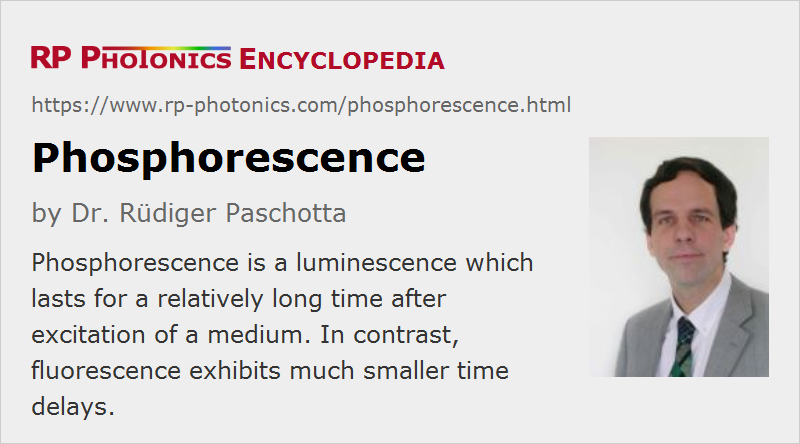Phosphorescence
Definition: a luminescence which lasts for a relatively long time after excitation of a medium
More general term: luminescence
German: Phosphoreszenz
Category: physical foundations
How to cite the article; suggest additional literature
Author: Dr. Rüdiger Paschotta
Phosphorescence is a kind of luminescence (i.e., a kind of light emission of a medium) which lasts relatively long after excitation of the medium (for example many milliseconds or more). The excitation energy is stored in metastable electronic states (often triplet states reached via intersystem crossings), exhibiting only forbidden transitions to lower states. There are also cases with delayed fluorescence, where one has an intersystem crossing to a triplet state and later on back to the original singlet state. Very long decay times can also occur due to thermally activated delayed fluorescence (TADF), where an involved thermal excitation is very slow because of an energy gap much larger than kB T. Some authors would not call that phosphorescence, although it is common to call certain substances phosphorescent where such traps play a vital role.
As the stored energy can be released only through relatively slow processes, phosphorescence is generally much weaker than fluorescence.
Important phosphorescent materials are europium-doped strontium aluminate (Eu2+:SrAl2O4) and zinc sulfide (Eu2+:ZnS). They are used e.g. in safety products such as exit signs, which are visible even under conditions of power failure, although they are not very bright. Phosphorus, from which the name phosphorescence was originally derived, actually exhibits chemoluminescence.
Fluorescent lamps also exhibit a low level of phosphorescence (an afterglow) of the phosphor for some time after being switched off.
Questions and Comments from Users
Here you can submit questions and comments. As far as they get accepted by the author, they will appear above this paragraph together with the author’s answer. The author will decide on acceptance based on certain criteria. Essentially, the issue must be of sufficiently broad interest.
Please do not enter personal data here; we would otherwise delete it soon. (See also our privacy declaration.) If you wish to receive personal feedback or consultancy from the author, please contact him e.g. via e-mail.
By submitting the information, you give your consent to the potential publication of your inputs on our website according to our rules. (If you later retract your consent, we will delete those inputs.) As your inputs are first reviewed by the author, they may be published with some delay.
See also: luminescence, photoluminescence, metastable states, phosphors
and other articles in the category physical foundations
 |





If you like this page, please share the link with your friends and colleagues, e.g. via social media:
These sharing buttons are implemented in a privacy-friendly way!